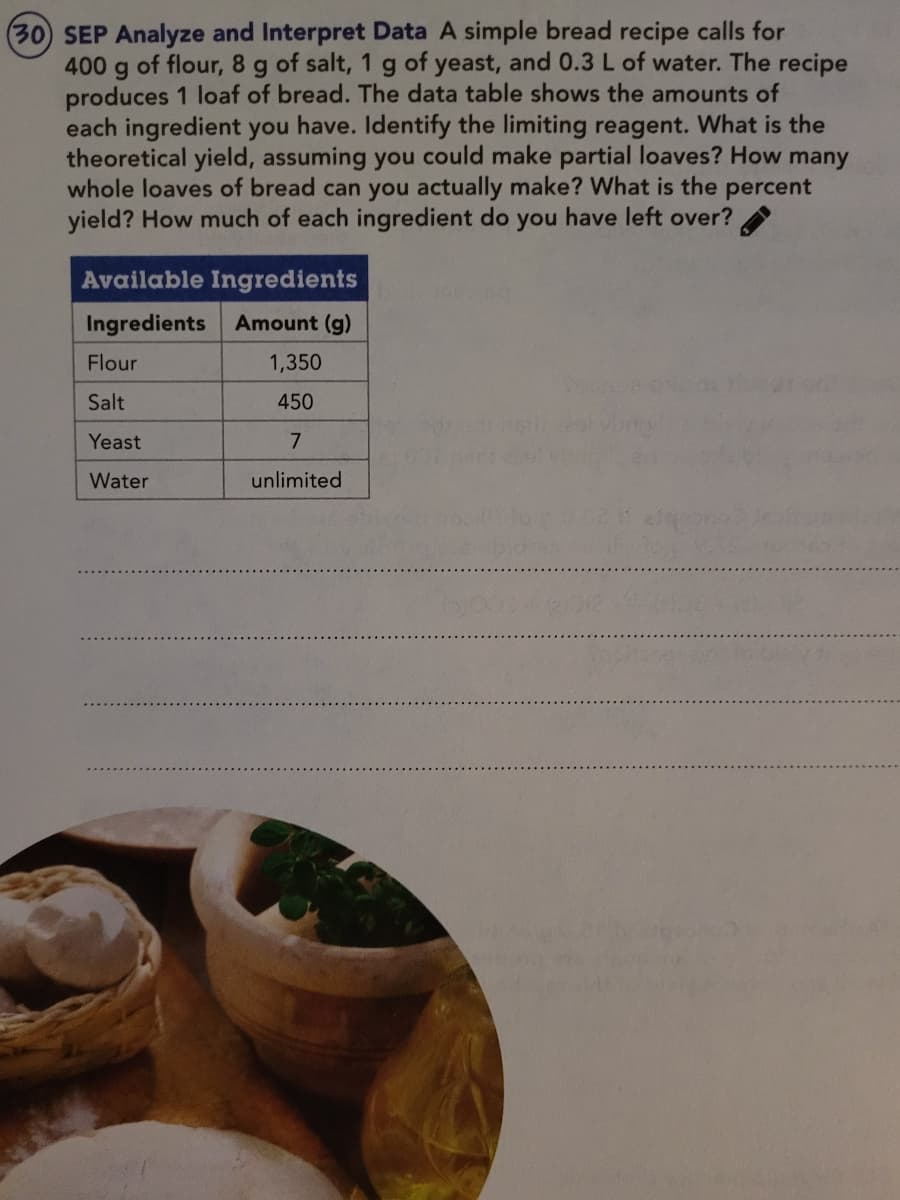SEP Analyze and Interpret Data A simple bread recipe calls for 400 g of flour, 8 produces 1 loaf of bread. The data table shows the amounts of each ingredient you have. Identify the limiting reagent. What is the theoretical yield, assuming you could make partial loaves? How many whole loaves of bread can you actually make? What is the percent yield? How much of each ingredient do you have left over? g of salt, 1 g of yeast, and 0.3 L of water. The recipe Available Ingredients Ingredients Amount (g) Flour 1,350 Salt 450 Yeast Water unlimited
SEP Analyze and Interpret Data A simple bread recipe calls for 400 g of flour, 8 produces 1 loaf of bread. The data table shows the amounts of each ingredient you have. Identify the limiting reagent. What is the theoretical yield, assuming you could make partial loaves? How many whole loaves of bread can you actually make? What is the percent yield? How much of each ingredient do you have left over? g of salt, 1 g of yeast, and 0.3 L of water. The recipe Available Ingredients Ingredients Amount (g) Flour 1,350 Salt 450 Yeast Water unlimited
Chemistry for Engineering Students
3rd Edition
ISBN:9781285199023
Author:Lawrence S. Brown, Tom Holme
Publisher:Lawrence S. Brown, Tom Holme
Chapter1: Introduction To Chemistry
Section: Chapter Questions
Problem 1.6PAE: Use the web to determine the differences in the amounts of aluminum recycled in states where there...
Related questions
Question

Transcribed Image Text:(30 SEP Analyze and Interpret Data A simple bread recipe calls for
400 g of flour, 8 g of salt, 1 g of yeast, and 0.3 L of water. The recipe
produces 1 loaf of bread. The data table shows the amounts of
each ingredient you have. Identify the limiting reagent. What is the
theoretical yield, assuming you could make partial loaves? How many
whole loaves of bread can you actually make? What is the percent
yield? How much of each ingredient do you have left over?
Available Ingredients
Ingredients
Amount (g)
Flour
1,350
Salt
450
Yeast
Water
unlimited
Expert Solution
This question has been solved!
Explore an expertly crafted, step-by-step solution for a thorough understanding of key concepts.
This is a popular solution!
Trending now
This is a popular solution!
Step by step
Solved in 3 steps

Knowledge Booster
Learn more about
Need a deep-dive on the concept behind this application? Look no further. Learn more about this topic, chemistry and related others by exploring similar questions and additional content below.Recommended textbooks for you

Chemistry for Engineering Students
Chemistry
ISBN:
9781285199023
Author:
Lawrence S. Brown, Tom Holme
Publisher:
Cengage Learning

Principles of Modern Chemistry
Chemistry
ISBN:
9781305079113
Author:
David W. Oxtoby, H. Pat Gillis, Laurie J. Butler
Publisher:
Cengage Learning

Chemistry: An Atoms First Approach
Chemistry
ISBN:
9781305079243
Author:
Steven S. Zumdahl, Susan A. Zumdahl
Publisher:
Cengage Learning

Chemistry for Engineering Students
Chemistry
ISBN:
9781285199023
Author:
Lawrence S. Brown, Tom Holme
Publisher:
Cengage Learning

Principles of Modern Chemistry
Chemistry
ISBN:
9781305079113
Author:
David W. Oxtoby, H. Pat Gillis, Laurie J. Butler
Publisher:
Cengage Learning

Chemistry: An Atoms First Approach
Chemistry
ISBN:
9781305079243
Author:
Steven S. Zumdahl, Susan A. Zumdahl
Publisher:
Cengage Learning